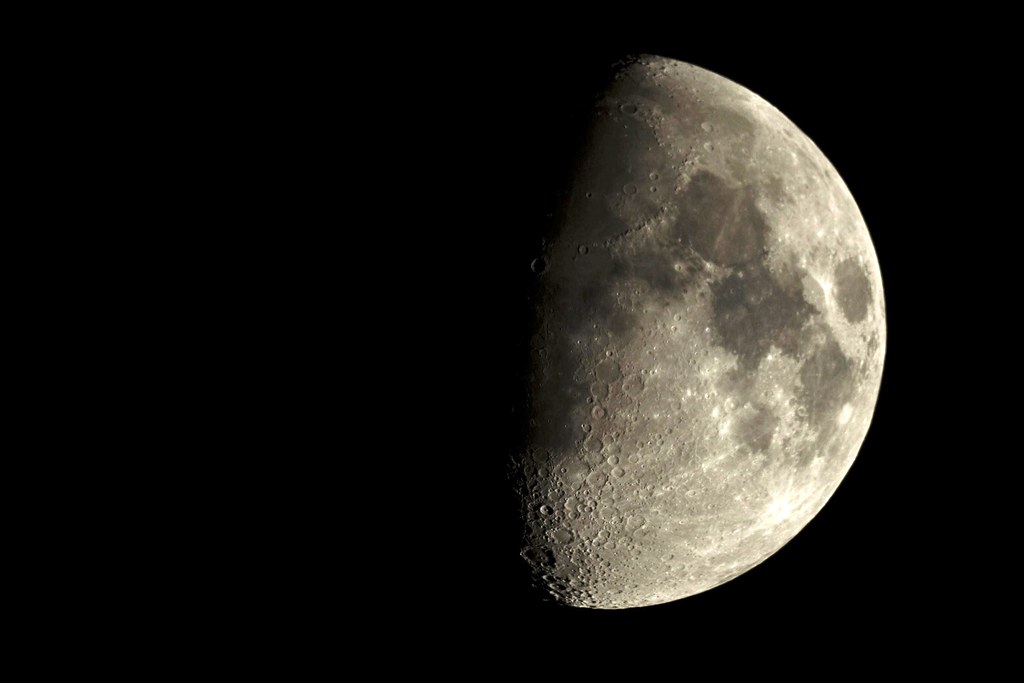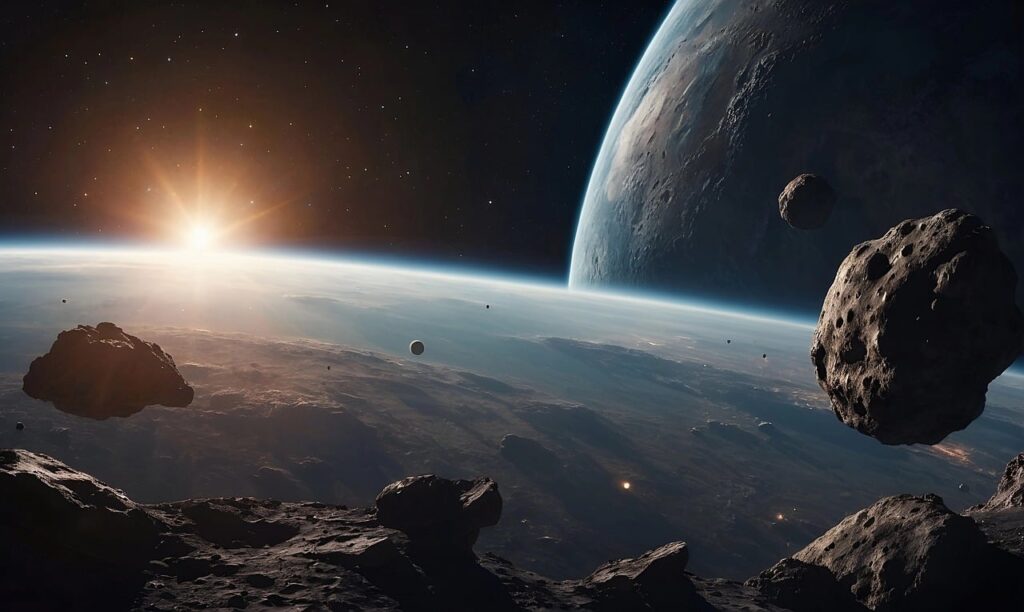The Moon has consistently accompanied Earth for over 4.5 billion years, serving as its sole natural satellite. This enduring relationship is pivotal to various environmental processes, notably the rhythmic rise and fall of ocean tides and the stabilization of Earth’s axial tilt. By exerting gravitational influence, the Moon not only shapes tidal patterns but also plays a significant role in regulating Earth’s geology and climate. Its presence has been essential in creating and maintaining conditions conducive to life on our planet.

The Moon had a great influence on the Earth.
During the cycles of the lunar phases, the Moon’s influence can be seen vividly. When full, the Moon’s gravitational pull is at its peak, leading to higher tides, while during the new moon phase, the opposite effect occurs. These tidal forces are not merely local phenomena; they have shaped the entire biosphere. Some species, such as certain fish and marine life, have reproductive cycles that are closely linked to the lunar calendar, showcasing the Moon’s integral role in Earth’s biology.
Beyond tides, the Moon’s gravitational stability has helped minimize extremes in Earth’s climate. It keeps the axial tilt relatively constant, which is essential in preventing drastic temperature fluctuations over millennia. This stability has allowed life to flourish in various forms, adapting to a relatively stable climate that has persisted through geological time.
Yet, despite its protective role, the Moon is slowly drifting away from Earth at a rate of about 38 millimeters per year. This phenomenon is a result of the complex gravitational interplay between Earth and its satellite, which can seem counterintuitive given the Moon’s role as a guardian. The Moon’s retreat can also be attributed to tidal forces, as Earth’s rotation exerts a drag on the Moon’s orbit, causing it to spiral outward over geological timescales.
To grasp the magnitude of this distance, consider the fact that the average distance from Earth to the Moon is approximately 384,400 kilometers. The Moon’s ongoing journey away from us may appear insignificant on a yearly scale, but over millions of years, this separation will lead to notable changes in the Earth-Moon system.
The idea that the Moon has always protected and nurtured the Earth raises intriguing questions about the future. As the Moon continues to drift further away, the effects on tides and Earth’s axial stability could become more pronounced, potentially leading to a different set of environmental conditions on our planet. While we may not witness these changes in our lifetimes, the implications for future generations and the delicate balance of Earth’s ecosystems are worth pondering.
Exploration of the Moon has been a significant aspect of human history and ambition. From ancient civilizations that worshipped the Moon to the modern space race that culminated in the historic Apollo 11 mission, humanity’s fascination with its celestial neighbor has driven scientific inquiry and exploration. The Moon has inspired countless myths, legends, and artistic representations throughout human culture, symbolizing a connection to the cosmos and offering a source of inspiration that transcends generations.

As we continue to study our nearest celestial companion, our understanding of its formation and role in the Earth-Moon system deepens. The prevailing theory posits that the Moon formed from debris resulting from a colossal impact between the early Earth and a Mars-sized body known as Theia. This cosmic event not only birthed the Moon but also imparted essential properties that have shaped its evolution.
The Moon’s surface tells a rich geological story marked by ancient impacts, volcanic activity, and the slow but steady pacing of time. Its diverse topography – from the dark, flat plains of the maria to the rugged highlands littered with craters – encapsulates the history of our solar system’s tumultuous past. Each exploration mission has peeled back layers of this history, offering insights into the formative processes that shaped Earth and its satellite.
The Moon’s retreat poses a natural curiosity, one that evokes deeper layers of inquiry. As we uncover the underlying mechanisms driving this process, we are compelled to reflect on humanity’s place in the universe. The Moon, revered for millennia, not only illuminates our nights but also serves as a reminder of the dynamic nature of celestial bodies and their profound impact on life on Earth.
Despite its gradual separation, the Moon remains an essential part of our planet’s identity. It plays a role not just in the physical realm but also in the cultural and spiritual dimensions of human existence. The Moon remains a beacon of exploration, inviting us to dream of future journeys and discoveries. As scientific missions resume, targeting a return to the Moon in the not-so-distant future, we are reminded that our relationship with this celestial neighbor continues to evolve.
Embracing the Moon’s narrative invites a broader appreciation of the natural world and the cosmos beyond. Its journey away from Earth, while a topic of scientific inquiry, also reflects the transient beauty of existence. As the Moon drifts further into the depths of space, it calls upon humanity to cherish the bond we share with our planet and its eternal companion. The Moon’s journey is a captivating story of cosmic dance, a reminder of the infinite wonders that lie beyond our horizon, and a testament to the enduring spirit of exploration that resides in us all.
The Moon’s retreat from the Earth at a rate of about 38 millimeters per year is not just a whimsical cosmic wander; it is steeped in deep scientific principles involving gravitational dynamics, tidal forces, and the unique history of the Earth-Moon system. The fascinating interplay between these celestial bodies has set the stage for a dynamic relationship that has evolved over billions of years. As we dive into the science behind this steady retreat, it is essential to grasp the fundamental forces at play and their implications for our planet and its future.
At the heart of this cosmic dance lies the principle of gravitation—a force that governs the interactions between the Earth and the Moon. The gravitational attraction between these two bodies is a critical factor in the Moon’s orbit. This pull keeps the Moon in a stable path around Earth, but it also leads to a phenomenon known as tidal friction. As the Earth rotates, the gravitational interaction causes the oceans to bulge out, creating high tides. These tidal forces are not static; they are dynamic and constantly evolving, influenced by the Moon’s position relative to the Earth.
Tidal forces exerted by the Moon have a profound effect on both the Earth and the Moon itself. While the Moon’s gravitational pull creates the tidal bulges on Earth, the Earth’s rotation is faster than the Moon’s orbital period. This misalignment results in the tidal bulge being slightly ahead of the Moon. As a consequence, the gravitational pull of this bulge serves to pull the Moon slightly forward, causing it to gain energy and gradually spiral outward. This process is akin to a cosmic game of tug-of-war, where Earth and the Moon are locked in a capable yet shifting equilibrium.
Moon moving awat from the Earth may make a difference in many aspects.
Over millions of years, this interaction has resulted in the Moon moving away from the Earth. To put this into perspective, consider that at its current rate of retreat, the Moon will be approximately 1.5 times farther away in about 600 million years. While this may seem like a slow process, the cumulative effects of such a shift are immense. The relationship between the Earth and the Moon has been incredibly stable, but it is this very stability that fosters an environment conducive to life. As the Moon drifts further away, scientists predict potential changes in tidal patterns, which could have significant effects on marine ecosystems and climate regulation.
The implications of the Moon’s gradual retreat extend beyond mere tidal forces. The Moon also plays a crucial role in stabilizing the tilt of the Earth’s axis. This axial tilt is responsible for the changing seasons, influencing the climate over geological timescales. The gravitational influence of the Moon helps maintain a consistent axial tilt, preventing drastic shifts that could lead to extreme climate variations. However, as the Moon continues its slow drift into space, the stability it provides might be compromised. This scenario raises questions about the long-term consequences for Earth’s climate and ecosystems, leaving scientists pondering the future trajectory of our planet.
Moreover, the Moon is not just a lifeless rock; it is a geologically active body that has undergone many changes since its formation. The Moon’s surface reveals a history of impacts, volcanic activity, and tectonic processes, providing insights into the early solar system’s dynamics. As the Moon moves away, it becomes increasingly challenging to study its geological features through direct exploration, especially as humanity sets its sights on Mars and beyond. Understanding the Moon’s evolution is crucial not only for lunar science but also for comparative planetology, shedding light on the processes that govern planetary development throughout the solar system.
The Moon has also served as a critical benchmark for our understanding of extraterrestrial bodies. From the first human landing on the lunar surface in 1969 to the ongoing robotic missions exploring its far side, the Moon has been a focal point of astronomical research. Future missions to the Moon, including the anticipated Artemis program, aim to deepen our understanding of its geology, resources, and potential for sustaining human presence. This exploration is particularly timely, as the Moon continues its retreat, and we endeavor to unlock its mysteries before it drifts too far away from our reach.
As we contemplate the science behind the Moon’s retreat, we encounter the beauty and complexity of our solar system. The Moon, with its bright glow illuminating our night skies, is a reminder of the intricate relationships that bind celestial bodies together. Its slow but steady movement away from the Earth invites us to reflect on our place in the universe and the transient nature of even the most stable relationships.
The Moon’s gradual retreat from Earth is a complex phenomenon rooted in the fundamental laws of physics. This gravitational relationship has significantly influenced the development of our planet and its environment. As the dynamics of the Earth-Moon system evolve, they raise crucial questions about the future of life on Earth and the adaptive mechanisms that may arise. Our enduring fascination with the Moon serves as a catalyst for exploration and curiosity, inspiring future generations to engage with the mysteries of our universe. Ultimately, the Moon’s journey exemplifies a profound narrative of discovery, highlighting the intricate connections that enrich our understanding of existence within the vast cosmos.
Related posts:
Wikipedia
The Moon is slowly moving away from the Earth and beginning to impact us
How much closer was the Moon say 200,000 years ago?





